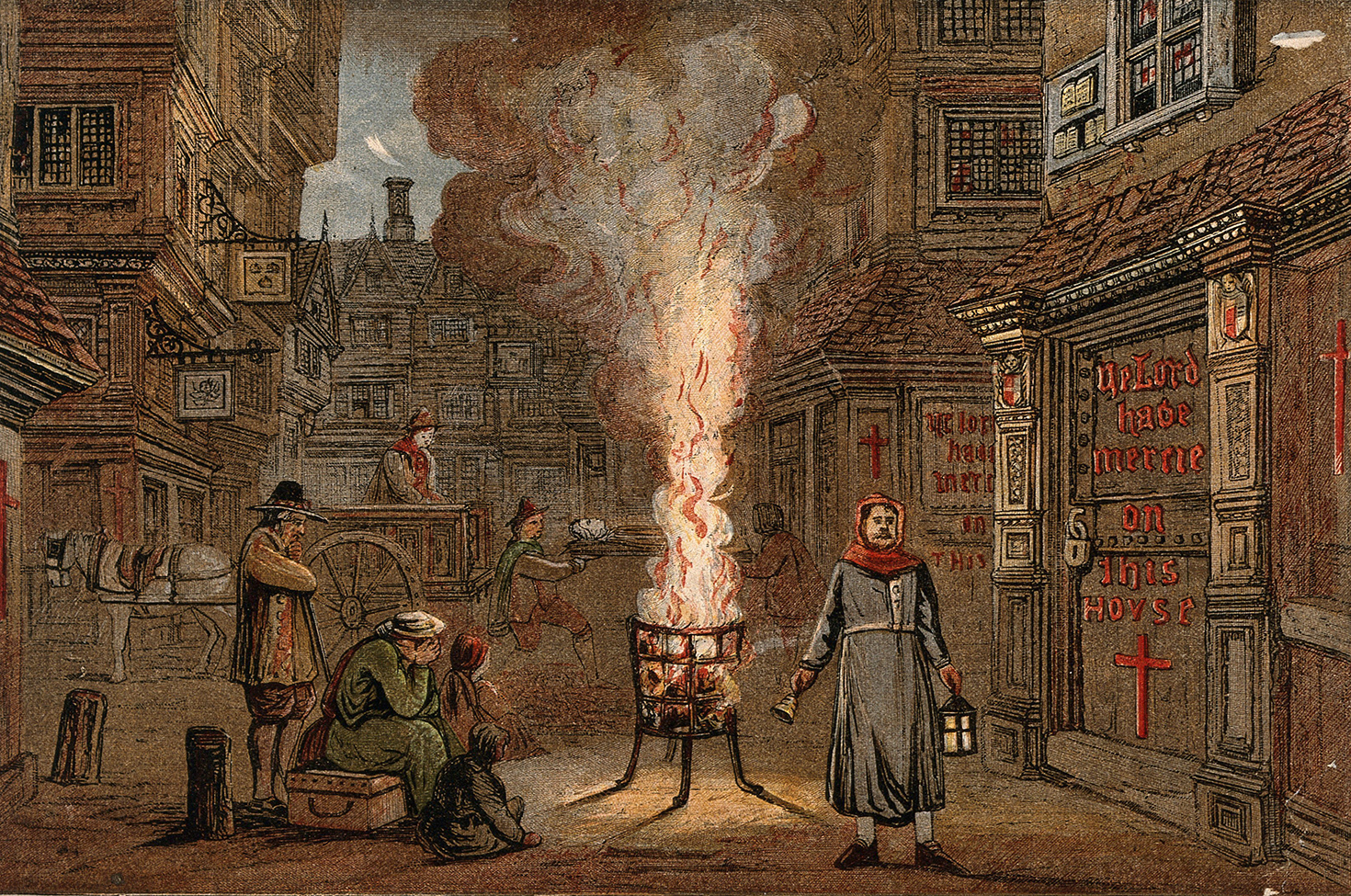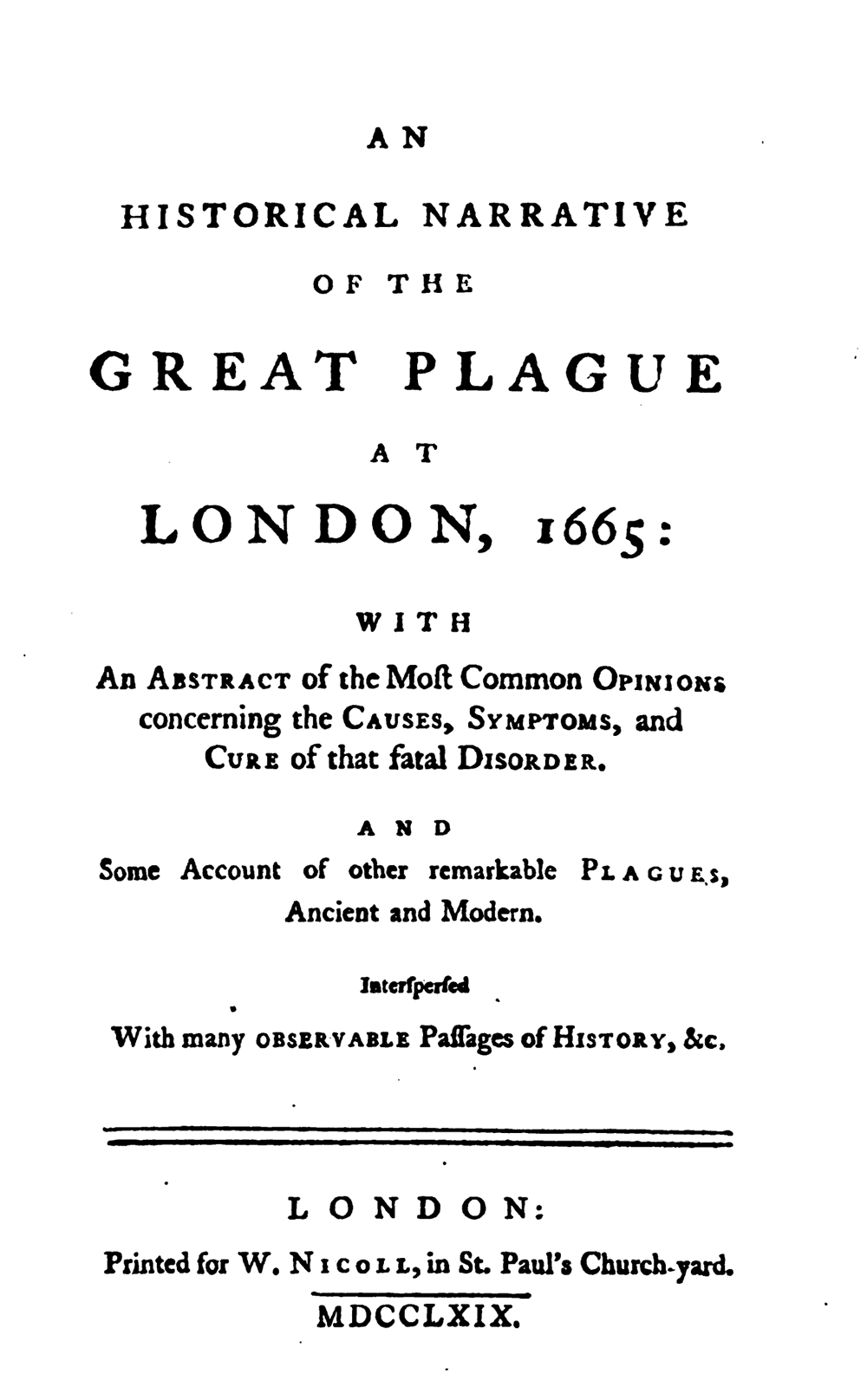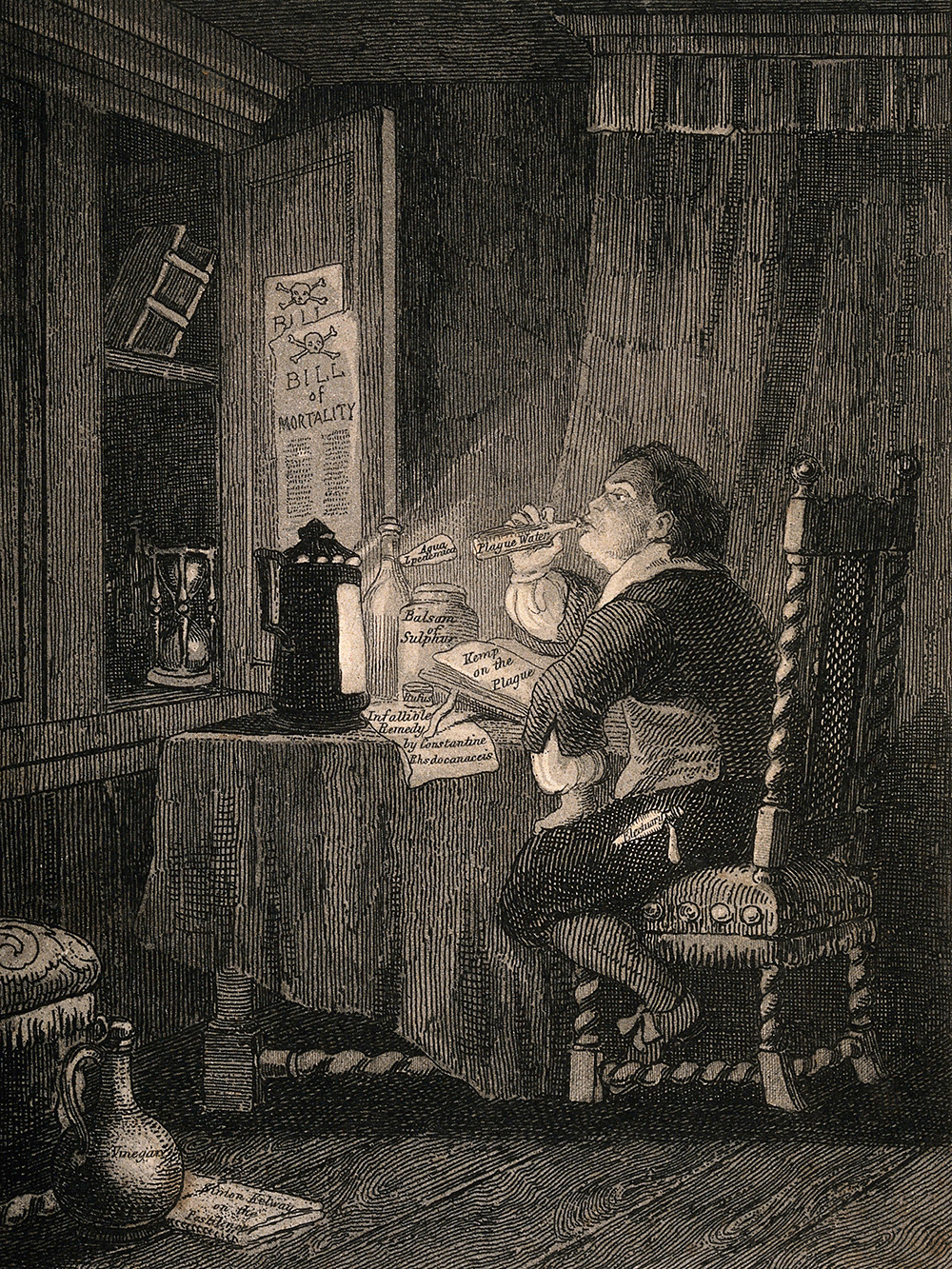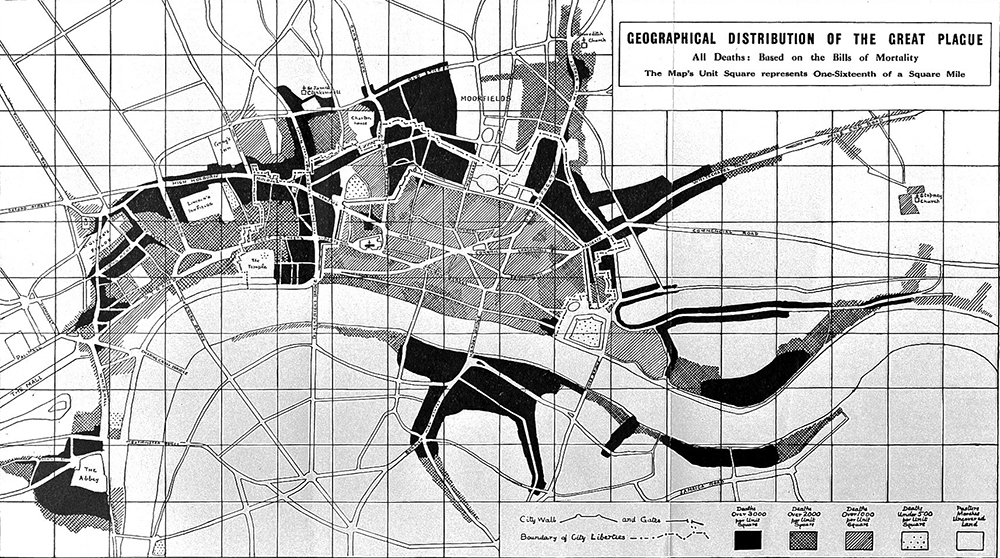
Bring Out Your Dead, by Edmund Evans. Wellcome Collection (CC BY 4.0).
Plague forced doctors to reflect on the bodies of the poor more than ever before. Never had physicians had such a pressing reason to theorize about the physiological implications of status.
Some bodies were more apt than others to sicken during an epidemic. The common term for this quality was predisposition. Any discussion of early modern contagion must address the paramount architect of contagion theory, Italian physician Gioralomo Fracastoro, and his 1546 book De Contagione. He placed corruption squarely at the heart of his theory: “Without some sort of putrefaction, there can be no contagion.” And he made a direct link between predisposition and class.
Galen had long ago suggested that contagious diseases struck only bodies “disposed” to receive infection. Both Galen and Fracastoro used the term seeds or semina to describe epidemic agents; keeping with that horticultural metaphor, predisposed bodies provided fertile soil for invading particles to take root, while other bodies were less welcoming. This idea accorded with a medical worldview that emphasized individual constitutional differences. It made little sense to a sixteenth- or seventeenth-century doctor to suggest that bodies would react uniformly to any foreign matter, force, or stimulus. Thousands of bodies were exposed to contagious effluvia or foul miasma in an urban epidemic, yet not all of them sickened. When Fracastoro addressed this issue, he pointed unmistakably to physiological class distinctions.
Now the nobility, on account of their wealth and other conveniences which the populace lacks, can take greater precautions against the sort of contagion that is transmitted from one person to another; but they can defend themselves less well than the populace from the contagion that depends on the air, since that sort of contagion, though common to all, is more prone to attack those who are rather delicate and less robust, and those who are more full-blooded and of a less dry temperament, and the nobility have these characteristics because of their luxury and life of ease. The populace, on the other hand, are more robust and of a drier temperament, because they exert themselves strenuously, and their diet is more frugal.
Notwithstanding his commitment to individual constitutions elsewhere in his work, Fracastoro was here clearly generalizing about entire social ranks. Bodies internalized their class’ lifestyle. Luxury or want, work or idleness, these factors inscribed deep changes in a body with profound implications for disease risk. Embedded in Fracastoro’s assertion therefore is the claim that social distinctions were physiologically vital—vital, literally, for it was on these distinctions that life or death might hinge.
Fracastoro’s book also warned elite readers that they faced the greatest risks in epidemics, while their social inferiors were relatively safe. He did not ascribe responsibility for plague to the poor. In 1564 English physicians like William Bullein still emphasized the sins of the luxurious rich. However, by the seventeenth century, English readers of De Contagione surely would have thought that Fracastoro had it backward.
Physicians Gideon Harvey and Nathaniel Hodges each witnessed the 1665 plague outbreak firsthand. Writing during the epidemic, Harvey answered that same perennial question—“Why are some bodies more exposed to the contagion than others?”—in traditional fashion, emphasizing predisposition and putrefaction especially among commoners, a point he signals with his reference to alehouses. “Because of their passive disposition of body and humours to receive the infection, and of being vitiated [corrupted] by it; to wit, by foulness of their bodies, abundance of bloud, oppression of the spirits, aperture of their pores, thinness of texture of body, intemperance, promiscuous converse with all sorts of people, whence the contagion oft lights in taverns, ale-houses, &c.” Hodges painted a similar picture. He emphasized the dietary origins of putrescence, identifying “common people” whose intemperate diet “very much contribute[s] to that disposition of body as made the pestilential taint more easily take place…such a way of living may raise the humours to a degree of putrefaction as brings fevers, very malignant and causes epidemical diseases.” If there were any doubt who Hodges meant, comments in a different text, one written in the midst of the epidemic, offered clarification. Promising more on the topic in his next book he apologized: “I have intentionally omitted very much which may seem pertinent to this business, as to assign the reason why the poor were mostly infected which I might have ascribed to the rotten mutton they fed on the preceding autume preparing their bodies for the contagion, their being crowded in little roomes and close alleys, as also their unrestrainable mixing and converse with the infected, and their great want and poverty notwithstanding the magistrates’ industrious provision for them.” Both Harvey and Hodges pointed to a quality in poor bodies that predated plague, and both used the term disposition to describe it. Each emphasized corruption and conveyed it in similar language: “putrefaction,” “vitiate,” “foulness.” Hodges chastised paupers who ate immoderately when food was cheap, and thus he, too, colored his picture with a moralizing tone about intemperance.

While concerns about alehouses seemed to target the immoral or disorderly poor, claims about diet and living conditions, which were much more prominent in plague treatises, cast a much wider net. Such claims implicated the underclass generally rather than the immoral poor specifically. These assertions allowed discussions of the pathogenic plebeian body to cut across, even to resist, those categories into which early modern commentators often situated the poor. Reformers often set the idle, unruly, or immoral poor apart from the upstanding, hardworking poor. Discussions of social welfare pitting the deserving versus the undeserving poor gave the clearest expressions of these categories, with the so-called sturdy beggar—who was fit but refused to work—providing a useful caricature.
Despite the constant presence of claims linking contagion to disorder or vice, threats about the pathogenic qualities of the plebeian body consistently crept beyond subgroups like criminals or vagrants to voice sweeping statements about the poor generally. Notwithstanding his claim about taverns, Harvey identified poor bodies as sources of plague elsewhere in ways that had implications far beyond alehouses. For example, he listed a series of “nasty trades” alongside the marshes, dung heaps, and other worrying sources of pestilential filth. As working Londoners and frequently the employers of other men, “Tallow Chandlers, Butchers, Poulterers, Fishmongers, and Dyers” probably would have considered themselves a cut above the drunken vagrants and beggars often targeted in plague orders. But as far as Harvey was concerned their filthy environments rendered their bodies just as corrupt and dangerous.
Harvey highlighted class in his book’s structure, offering separate discussions of his “curative medicines both for rich and poor.” At first glance, his book seems to promise a range of differently priced medicines suitable for all pocketbooks. And indeed, it does. However, a closer reading shows that Harvey’s medical distinctions stem from a deeper sense that classed physiologies differed. Compare his medicines for each.
Distinction XIV, Preservatives for the Rich
The ingredients being prescribed in their substance do not suddenly exhale or depose their virtues, but maintain the bloud in a gentle fermentation for a whole day and night, actuate the spirits, absorbe the intestinal superfluities, reclude oppilations, mundifie the bloud, oppugn putrefaction, gently expell and work out all contagious Seminaries through the pores, and all this without inflaming the body, which makes it sutable to all temperaments.
Distinction XV, Preservatives for the Poor
Cacochymies or fowl bodies of the Vulgar, contracted through course and dreggish feeding do require strong Purges, or rather vomits once or twice repeated, among which for its cheapness and excellency in evacuating, deoppilating, and expelling all malignity, we prefer this following…
Of course, the cheap availability of the common ingredients like juniper berries, rue, and myrrh that followed the second quotation tells part of the story. However, much more telling is how these bodies needed different treatments. The term gentle recurs in Harvey’s discussion of medicine for the rich, which mildly cleansed delicate elite bodies. Vulgar bodies, on the other hand, needed much stronger medicine, because—and this is the crucial point—they were “fowl.” The term Cacochyme stemmed from the Greek words for “bad” and “juices” and referred to the physiological state of possessing corrupt fluids. Plebeian putridity thus remained the key issue.

The policing of beggars during epidemics is useful to revisit in light of medical theory. Consider, for example, the 1630 orders issued by London’s lord mayor. The sheer proximity of rules about vagabonds and those about filth expresses dynamically the underlying medical assumption that paupers’ bodies were, like dunghills, sources of dangerous physical corruption.
First, that all the severall Inhabitants within this city and liberties thereof, doe from hence forth daily cause their houses to be kept sweet, the streets and lanes before their doores to bee paved, and cleansed of all manner of soile, dung, and noisome things whatsoever, and the channels thereof to be kept cleane, and washt, by water to be poured down, or let running into the same.
That no vagrants or beggars doe presume to come, or presse together in multitudes to any buriall, or lectures, or other publike meetings, whereby to seeke or gaine reliefe as hath beene lately vsed, but that they and every of them vpon every buriall, doe repaire to such places to receiue the almes, charity or reliefe, as they shall have notice given them by the officers of the parish, wherein they doe reside.
That no idle vagaband, and vagrant persons doe presume to come, wander or remaine in and about this citie and liberties thereof, either to begge reliefe or otherwise. And if any of them shall be found, or taken to offend therein, Then they and every of them to be apprehended by the constables and warders within this citie, and being punished, to be passed away according to the lawes and statutes of this realme, in that case made and provided for.
Ridding the city of beggars’ foul blood went hand in hand with removing other rotten substances.
Nathaniel Hodges published an earlier treatise during the epidemic that invites exploration of a different way that discussions of plague and fever inscribed class on the body. His 1665 treatise Vindiciae Medicinae & Medicorum advocated the practice of bloodletting for diseases in which “the blood is depauperated.” From the Latin depauperata, depauperated was a rarely used term meaning to be impoverished. Hodges thus recommended letting “impoverished” blood. Before 1665, depauperated appears to have been used in English almost exclusively in an economic sense. For example, though it is hardly exhaustive, Early English Books Online yields just a handful of sixteenth- or early-seventeenth-century vernacular texts using the term or its derivatives, all of which convey literal economic impoverishment.

The first English-language texts to use depauperate in a medical sense appeared during the 1665–66 epidemic. Hodges’ treatise responded to a series of critiques of Galenic medicine by members of the Society of Chemical Physicians, especially George Thomson’s 1665 Galenopale; or, A chymical trial of the Galenists, which criticized phlebotomy for plague. Thomson warned that by traditional Galenic treatments like bloodletting “the malignity [is] detained, the blood made restagnant, the vital spirits depauperated, losing their activity and force, becoming torpid and careless to preserve themselves, and the morbifick matter more tenacious.” Three treatises published during the epidemic described the blood of plague or fever patients as impoverished. What did it mean?
Can it be that in the midst of the last great epidemic, when voices from all corners warned about the pathological bodies of the poor—emphasizing the quality of their blood—medical writers appropriated the language of poverty to describe the physiological qualities that infected bodies took on? It certainly seems the case.
Adapted from Rotten Bodies: Class and Contagion in Eighteenth-Century Britain, by Kevin Siena, just published by Yale University Press. Copyright © 2019 Yale University Press. Reprinted by permission of Yale University Press.
